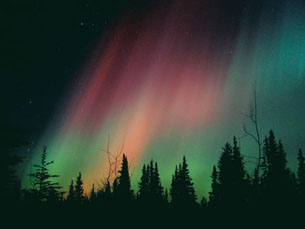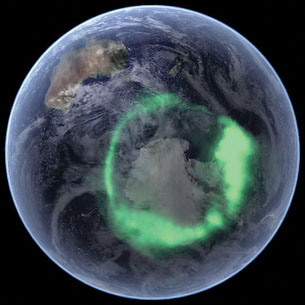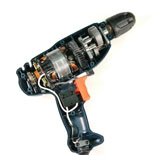Module 4
1. Module 4
1.1. Big Picture
Module 4—Magnetic and Electric Fields in Nature and Technology
 Big Picture
Big Picture

© Walter S. Becker/shutterstock

Image courtesy NASA
In the night sky of northern Alberta you can see some of the planet’s most fantastic light shows. The photograph on the left is of the aurora borealis (aka northern lights). The image on the right is of the aurora australis (aka southern lights) over Antarctica and was taken from space with Nasa’s IMAGE satellite. The aurora australis is overlaid on a clear image of NASA’s “Blue Marble.”
The auroras occur when some of the charged particles in the solar wind are trapped in Earth’s magnetic field. As they spiral downward along field lines they interact with atoms in the atmosphere. It is this interaction that results in the light show. Aside from being very beautiful, they were also responsible for some of the very early observations that linked electric and magnetic fields. For example, on September 2, 1859, a very intense solar wind (charged particles given off by the sun) created an aurora so bright that people could read outside at night. At exactly the same time, hundreds of thousands of kilometres of telegraph cable were disrupted and some lengths of it began to function without battery power. Apparently, whatever was creating the aurora was also creating a current in some of the telegraph cables. People began to suspect that electrical and magnetic phenomena were somehow linked.
Today the connection between electric and magnetic fields and forces is well understood and has led to innovations and technologies that support our lifestyle. Examples of this connection include the electrical generators and motors that are connected throughout the North American electrical grid.
In Module 4 you will explore power generation and consumption in devices such as generators and electrical motors.

© Igor Karon/shutterstock

© Brandon Blinkenberg/shutterstock
In the photograph on the left, turbines spin generators that convert mechanical energy into electrical energy. The photograph on the right shows an electric drill designed to convert the electrical energy produced by the generators back into mechanical energy that can be used to do work on other objects. How is this facilitated by the properties of electric and magnetic fields and forces?
By the end of Module 4 you will understand the interaction of electric and magnetic fields in the conversion of electrical and mechanical energy.
As you are working in Module 4, keep the following questions in mind:
-
What is the cause and nature of a magnetic field?
-
How are moving charges affected by a magnetic field?
- How are current-carrying conductors affected by magnetic fields?
 Module Assessment
Module Assessment
Each lesson has a teacher-marked assignment, based on work completed in the lesson. In addition, you will be graded on your contributions to the Discuss section of each lesson.
You will also be asked to complete Self-Check or Try This questions, which you should place in your Physics 30 course folder. These are not formally assessed but are a valuable way to practise the concepts and skills of the lesson. These activities can provide you with reflective feedback on your understanding of the lesson work.
You will be marked for your lesson work on the following items:
-
Module 4: Lesson 1 Assignment
-
Module 4: Lesson 2 Assignment
-
Module 4: Lesson 3 Assignment
At the end of the module you will complete a module assessment that consists of two diploma-style written-response questions. The first question will assess your knowledge of charge-to-mass ratios, and the second question will assess your knowledge of electromagnetic induction. See the Module Summary and Assessment page for more information. If you have any questions contact your teacher.